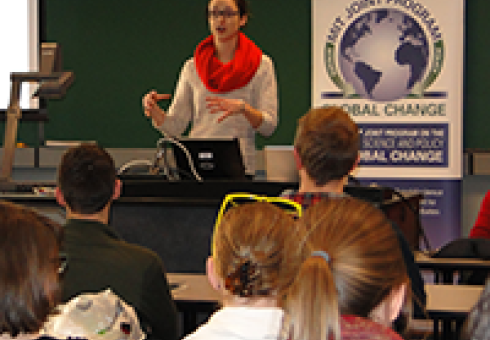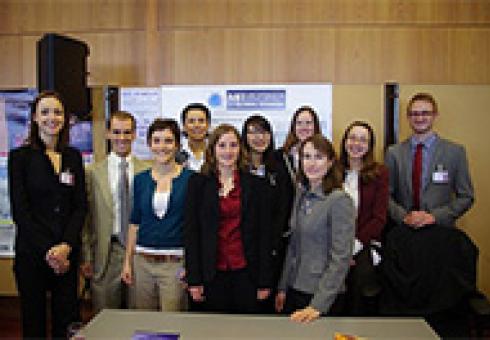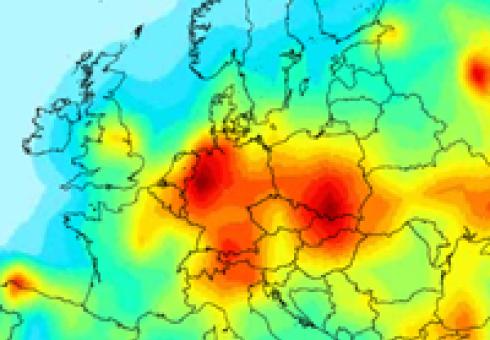The Global Young Academy (GYA) is an international group of two hundred young (up to ten years post PhD) scientists selected based on research excellence and commitment to impact. Through GYA, members are linked to the senior international academy network IAP, meet outstanding leaders of the international science community and may be nominated to contribute to international policy statements and working groups. Appointments are for a period of four years.
Selin's research focuses on using atmospheric chemistry modeling to inform decision-â€making strategies on air pollution, climate change and toxic substances including mercury and persistent organic pollutants. She has also published articles and book chapters on the interactions between science and policy in international environmental negotiations, in particular focusing on global efforts to regulate hazardous chemicals and persistent organic pollutants.
Selin, who will be formally appointed at a GYA symposium on May 21st, says she is very much looking forward to leveraging her new appointment to expand the reach of her science-policy work and educational initiatives.
News and Outreach: Noelle Selin
International leaders have gathered this week in Kumamoto, Japan to sign a landmark treaty to curb the use of mercury. The treaty, named the Minamata Convention after a Japanese city where serious health damage occurred from mercury pollution in the mid-20th Century, is both wide-ranging and legally binding. MIT researcher Noelle Selin is attending the conference and presenting research on the impacts of mercury pollution and the importance of policies to control it.
Selin was part of an expert panel discussing the science of and policies regarding mercury pollution this weekend, hosted by the National Institute of Minamata Disease and the Society of Environmental Toxicology and Chemistry.
Learn more about the UNEP event: United Nations Convention Tackling Hazardous Mercury To Open for Signature
Learn more about Dr. Selin’s mercury research:

Will the New Global Mercury Treaty be Effective?
MIT researcher Noelle Selin assesses the challenges of implementing the first global mercury treaty.
MIT students participate in the final mercury talks resulting in an international treaty.

Strategies to Reduce Mercury Revealed Ahead of International Talks
Harvard, MIT researchers map future trends of mercury and ways to reduce it on eve of international negotiations.
Keeley Rafter
Engineering Systems Division
Noelle Selin, assistant professor of engineering systems and atmospheric chemistry, along with Amanda Giang (Technology and Policy Program graduate) and Shaojie Song (Department of Earth, Atmospheric and Planetary Sciences PhD student), recently traveled aboard the specialized NCAR C-130 research aircraft as part of a mission to measure toxic pollution in the air.
The team participated in the Nitrogen, Oxidants, Mercury and Aerosol Distributions, Sources and Sinks (NOMADSS) project. The NOMADSS project integrates three studies: the Southern Oxidant and Aerosol Study (SOAS), the North American Airborne Mercury Experiment (NAAMEX) and TROPospheric HONO (TROPHONO). Selin’s group focuses on the mercury component.
“Mercury pollution is a problem across the U.S. and worldwide,” Selin says. “However, there are still many scientific uncertainties about how it travels from pollution sources to affect health and the environment.”
Selin and her students used modeling to inform decisions about where the plane should fly and to predict where they might find pollution. Their collaborators at the University of Washington aboard the aircraft captured and measured quantities of mercury in the air, conducting a detailed sampling in the most concentrated mercury source region in North America.
“It was really exciting to experience first-hand how measurements and models could support each other to address key uncertainties in mercury science,” Giang says.
The main objectives of this project include constraining emissions of mercury from major source regions in the United States and quantifying the distribution and chemical transformations of mercury in the troposphere.
NOMADSS is part of the larger Southeast Atmosphere Study (SAS), sponsored by the National Science Foundation (NSF) in collaboration with the National Oceanic and Atmospheric Administration, the U.S. Environmental Protection Agency and the Electric Power Research Institute. This summer, the Southeast Atmosphere Study brought together researchers from more than 30 universities and research institutions from across the U.S. to study tiny particles and gases in the air from the Mississippi River to the Atlantic Ocean, and from the Ohio River Valley to the Gulf of Mexico. The study aims to investigate the relationship between air chemistry and climate change, and to better understand the climate and health impacts of air pollution in the southeastern U.S.
Last month, the United Nations Environment Programme agreed on the first major environmental treaty in over a decade. Its focus was reducing mercury pollution. There to participate in the events were ten MIT students and their instructor Noelle Selin, a researcher with the Joint Program on the Science and Policy of Global Change and an assistant professor of atmospheric chemistry and engineering systems.
To share their experiences and lessons learned from witnessing international environmental policy-making in action, Selin and the students hosted a panel discussion on Wednesday, February 6.
Selin kicked off the event by describing the problem of mercury in our environment and why an international treaty was essential to curbing the environmental and public health effects. She explained that mercury levels in the Earth have increased greatly due to the burning of fossil fuels, cement production, and more. Mercury then rains down into oceans, where it contaminates fish as toxic methylmercury.
"The health risks to consumers of fish include neurological effects, particularly in the offspring of exposed pregnant women," Selin explained. “Over 300,000 newborns in the U.S. each year are at risk of learning disabilities due to their elevated mercury exposure."
Mercury is an element that cycles in the environment, meaning that once it’s released into the atmosphere it can take decades to centuries for mercury to make its way back to ocean sediments.
“This becomes a global issue, this becomes a long term issue, and thus an issue for international cooperation,” Selin said.
There were five student teams on the trip that covered topics including: governing institutions, products and processes, emissions, waste/trade/mining, and finance. A member from each team presented on their issue at the panel and shared their thoughts and observations on the international negotiation process.
Philip Wolfe, a PhD candidate in the Department of Aeronautics and Astronautics, discussed the institutions and policy process of the negotiations. He explained that the treaty has to work on two levels: globally and domestically.
“Individual countries engage in regional, domestic, or bilateral agreements and they’ll only really sign on to a global convention if it also meets their own domestic goals,” Wolfe said.
The treaty, if nations decide to sign it, would require tightly controlling emissions – a major area of discussion during the negotiations.
Leah Stokes, PhD candidate in Environmental Policy and Planning, discussed the challenges with regulating emissions from the burning of fossil fuels and artisanal small-scale gold mining. She explained that when individuals want to mine gold and don’t have any equipment they use mercury because it binds with gold. When burned together, the mercury burns first, leaving gold behind. This process is estimated by the United Nations to be the largest global contributor of mercury emissions.
“We also come into contact with mercury through a lot of the products we use,” explained Ellen Czaika, a PhD candidate in Engineering Systems Division.
Examples of products with mercury that will be phased out under the treaty include some types of compact fluorescent light blubs, dental fillings, pesticides, thermometers, and batteries. There were important discussions at the conference about weighing the benefits of some of these products versus their mercury risks, Czaika said.
Mercury mining is another source of concern, and a major piece of the treaty. Danya Rumore, a PhD student in Environmental Policy and Planning, explained that this was expected to be a big area of contention, but an agreement was reached that gave time for a ban to come into effect over a 15-year period.
Julie van der Hoop, a PhD student in the MIT/Woods Hole Oceanographic Joint Program, followed financial and technical assistance issues at the negotiations. She discussed how the strength and effectiveness of the treaty will be shown through the technology transfer programs, a new funding mechanism for developing nations, and implementation plans.
Ultimately, she said, “We’re looking for a treaty to be effective…If you make a treaty and it’s not effective then what’s the point?”
Many of the panelists said that the treaty has relatively weak requirements, but that this is still a historic and impactful international environmental treaty. Selin recognized that it had to be an agreement that all 140 countries would be able to sign on to and that any limits on mercury will have long-term impacts because of the nature of the mercury cycle.
“This isn’t a thing that ends today,” Stokes, of Environmental Policy and Planning, said. “This is just something that keeps going and going and going. Even though we have a treaty—really, we’re going to decide everything [about implementation] at the next meeting.”
The students attended the conference as part of a National Science Foundation grant, with the idea being to train a cohort of graduate students for science policy leadership through a semester-long course and an intensive policy engagement exercise. The group had UN observer status and was able to observe all of the negotiations, breakout sessions, and meetings. The students also presented their latest scientific information about mercury through a poster presentation, and shared their experiences and observations through a blog and twitter feed.
Dr. Noelle Selin of the MIT Joint Program on the Science and Policy of Global Change has been selected as one of 20 Leopold Leadership Fellows for 2013. She is the first fellow to be selected from the Massachusetts Institute of Technology.
Based at the Stanford Woods Institute for the Environment, the Leopold Leadership Program provides outstanding academic environmental researchers with skills and approaches for communicating and working with partners in NGOs, business, government and communities to integrate science in to decision making.
Selin is among the 20 mid-career academic environmental researchers named as fellows this year. The group was selected through a highly competitive process on the basis of their exceptional scientific qualifications, demonstrated leadership ability, and strong interest in sharing their knowledge beyond traditional academic audiences. The fellows will take part in intensive leadership and communications training designed to hone their skills in engaging with decision-makers, media, and the public. They also become part of a network of past fellows and program advisors who are working with leaders, both within and outside academia, to solve society’s most pressing environmental and sustainability challenges.
The 2013 fellows are doing innovative research in a wide range of disciplines, including ecology, marine science, economics, behavioral science, entomology, engineering and planning. They join a network of 175 past fellows who areengaged in broad-based efforts to solve society’s most pressing sustainability challenges.
Big deal, little fanfare over global pact on mercury controls
By Carol J. Williams
January 23, 2013
It’s a highly toxic element that travels the world in mysterious ways, respects neither manmade nor natural boundaries and rapidly accumulates in people and the food they eat.
Mercury’s risks for human and environmental health have slowly but steadily come to light over the centuries, leading to ad hoc phase-outs of mercury-filled thermometers, dental amalgam and the felt-hat-shaping compound that caused brain damage in 19th century milliners, giving rise to the term “mad as a hatter.”
U.S. and European governments have invoked strict regulations in recent decades to reduce mercury emissions. But fresh research by the United Nations Environmental Program and U.S. and European scientists has documented a concurrent rise in mercury emissions in Asia, Africa and the Arctic Ocean region, underscoring that mercury is a global problem in need of a collaborative solution.
A legally binding agreement to reduce emissions that was reached this past weekend at U.N.-sponsored talks in Geneva drew little notice or fanfare, probably because it still faces the rigors of ratification in 140-plus countries that will take another two to four years.
Still, getting so many states with competing economic agendas and disparate means to commit to the plan was no small feat--and not a minute too soon, in the view of environmental advocates spooked by mounting evidence of mercury’s dangers.
A European Union-coordinated study of 4,000 residents in 17 countries over the last two years found mercury levels in one-third of the test group to be above the amount considered safe, suggesting a causal link with brain damage in newborns.
“Mercury has been known as a toxin and a hazard for centuries, but today we have many of the alternative technologies and processes needed to reduce the risks for tens of millions of people, including pregnant mothers and their babies,” said Achim Steiner, the U.N. Environment Program chief, in heralding the successful conclusion of the decade-long International Negotiating Committee on Mercury.
Studies released by the U.N. agency ahead of the culminating negotiations lent urgency to the forum’s mission. In the world body’s "Global Mercury Assessment 2013," emissions of toxic metals from artisanal gold mining were shown to have doubled since 2005. Researchers attributed some of the rise to more thorough reporting from developing nations, but blamed more of it on the lure of record prices commanded for the precious metal.
A separate U.N. study said coal burning was responsible for about 24% of mercury emissions globally each year, with a heavy concentration in Asia, where smokestacks lack the emissions-scrubbing equipment widely used in North America and Europe.
Franz Perrez, international affairs division chief for Switzerland’s environmental office, attributed the unusual unity of purpose that secured the mercury pact in Geneva to a forum less subject to the rich-poor divides bedeviling the world body’s pursuit of a climate change treaty.
“There are some differences over financing and burden-sharing and over the compliance mechanism, but these are typical,” said Perrez, adding that he heard nothing to suggest ratification would be a problem.
Horse-trading remains to be done on helping developing countries switch to technologies that capture mercury emissions at the source and phase out antiquated and dangerous mining practices, said Noelle Selin, a professor of engineering systems and atmospheric chemistry at the Massachusetts Institute of Technology.
Mercury controls have been practiced on a voluntary basis by leading industrial countries in recent years, but “the advantage of having a treaty is that it is a strong legal statement that mercury is a problem and sets guidelines and timelines for reducing its major sources,” Selin said in a phone interview from the Geneva forum.
Selin and Harvard University colleague Elsie Sunderland published an appeal in the journal Environmental Health this month for aggressive emissions reductions and pointed to the European Union study showing as many as 2 million children born on the Continent each year with mercury-induced IQ deficiencies. The study calculated that the mental health damage costs European society $12 billion a year in lost income.
How mercury that has accumulated in the environment for millennia migrates the globe and transforms as it mixes with air, soil and water isn’t well understood, said James Hurley, director of the University of Wisconsin Aquatic Sciences Center. But an experiment he conducted over the last seven years found that new emissions from industrial activities and mercury released from melting Arctic ice and thawing permafrost were far more hazardous to the food chain than deposits in the ground.
Mercury released from coal-fired plants that falls into lakes or watersheds converts to methylmercury in water and is absorbed first by plankton, then by the fish that feed on it. To determine how quickly the element enters the food chain, Hurley put about three times the amount of mercury into one of Canada’s Experimental Lakes as would naturally make its way into the water body from rainfall and adjacent wetlands.
“We got a rapid response to new mercury added to the lake,” Hurley said. “More and more of the stable isotope kept accumulating in predator fish.”
Even more significant, he said, was the finding that as soon as researchers ceased adding mercury to the lake, absorption of it in fish responded with a parallel decline.
“By eliminating the amount of mercury in the atmosphere, we hopefully will be seeing improvement in mercury levels in fish,” Hurley said, predicting what passes for rapid rewards in environmental recovery if the global compact on mercury regulations moves ahead.
A foreign correspondent for 25 years, Carol J. Williams traveled to and reported from more than 80 countries in Europe, Asia, the Middle East and Latin America.
Paint Pigment, Violent Raccoons and Other Surprising Mercury Trivia
January 18, 2013
By: Jenny Marder
Delegates gathered in Geneva this week to negotiate for a global treaty to regulate the toxic chemical mercury.
I want to call your attention to a blog on "issues relevant to mercury pollution," run collectively by a group of MIT graduate students. They have been attending the United Nations talks on mercury in Geneva, Switzerland, which are due to wrap up today. Their posts are clever, funny and packed with interesting facts.
For example, did you know that the use of mercury dates as far back as 5,000 B.C.? In Spain, the Romans relied on slave labor to mine mercury, which they used as pigment in their paint. In fact, mercury-laden paint was found in homes "buried by the volcanic ash of Mount Vesuvius in 79 A.D.," the post reads. Cool, huh?
In the blog, the students document mercury's presence in popular culture, with a nod to a 1979 horror film called "Prophecy" in which "mercury waste from a logging company creates violent raccoons, salmon large enough to eat a duck and, worst of all, a giant bear-monster that may also be a reincarnated, evil forest spirit." Here's a clip.
They write of the not-so-subtle music choices -- namely Queen's "Under Pressure," which has been broadcast repeatedly over the conference loudspeaker. After noting the Freddie Mercury connection, they suggest a more appropriate playlist, which includes "Running out of Time" by Hot Hot Heat and "Mercury Poisoning" by Graham Parker and the Rumour.
And there's this gem, written from the perspective of a mercury atom floating in a delegate's water bottle.
And most importantly, they address how little people know about mercury and the risks it poses to the environment and human health. Neurological problems, memory loss and kidney, thyroid and pulmonary system problems can occur as a result of exposure to high concentrations. Vaporized mercury can easily pass from your lungs into your blood stream and damage tissues, according to this post. A growing body of evidence, this post notes, indicates a causal relationship between methylmercury and cardiovascular disease, such as heart attacks and increased blood pressure. People working in mercury mining and refining, thermometer production, dentistry, and in the production of mercury-based chemicals are at increased risk.
Plus, here's mercury in seafood, explained.
In brief, mercury is methylated to methylmercury (CH3HgX) by bacteria in the ocean and then accumulates in fish and marine mammals. Long-lived predatory fish at the top of the food-chain, such as swordfish, tilefish, shark, and tuna, can accumulate dangerously high concentrations of mercury. The US EPA lists guidelines for safe consumption of fish. Women who are pregnant or who could become pregnant should be especially careful about eating mercury contaminated fish because the mercury can be harmful to the developing fetus.
By Brian Bienkowski and Environmental Health News
January 18, 2013
As United Nations delegates end their mercury treaty talks today, scientists warn that ongoing emissions are more of a threat to food webs than the mercury already in the environment.
At the same time, climate change is likely to alter food webs and patterns of mercury transport in places such as the Arctic, which will further complicate efforts to keep the contaminant out of people and their food.
University of Wisconsin researchers recently found that mercury added to a lake reached top predators faster than the mercury that already existed in their environment.
“It was amazing how fast the mercury got into the fish,” said James Hurley, project researcher and director of the university’s Water Resources Institute in Madison.
And this was no lab experiment – researchers put mercury into Lake 658, part of the Experimental Lakes area in Ontario, Canada. Over a year, they put about three times the amount normally received through rainfall and nearby wetlands.
For mercury to show up in top lake predators, it has to be converted to methylmercury – mercury’s toxic form -- by organisms. Then it has to move up through the food web.
At Lake 658, this happened within months.
“We started seeing the isotope we added in June accumulate in yellow perch by early fall,” Hurley said. “By the start of the second year, we were clearly seeing it even in predatory fish.”
Before this study, researchers didn’t have any idea about how long it took for mercury to move through the environment, said David Krabbenhoft, a research hydrologist with the U.S. Geological Survey’s Wisconsin Water Science Center.
Once researchers stopped adding mercury, the concentrations in fish dropped quickly.
The discovery that new mercury seems to be more of a threat than old mercury could add impetus for reducing global emissions. Critics of mercury rules often say that because mercury is an element that recirculates, new emissions have minimal impact compared with historic and natural ones.
The United Nations today adjourns a meeting in Geneva where governments of about 130 nations have been debating a mercury reduction treaty.
Asia is by far the largest source of new mercury emissions, and coal-burning power plants are the top contributor. Small-scale gold production and residential heating from other fossil fuels are other major sources.
Exposure to high levels of mercury, often from consumption of fish and other seafood, can damage developing brains, reducing children’s IQs. It also has been linked to cardiovascular effects in some adults and children.
The UN released a report leading up to the conference that showed the amount of mercury in the world’s oceans has doubled in the past century.
And global emissions are rising. An increase equivalent to about one-quarter of the 2005 human-caused mercury emissions, or about 500 tons per year, is expected by 2020 if there are no major changes in economic trends or emissions, according to a 2011 report by the Arctic Monitoring and Assessment Programme.
Climate change complicates transport
Human-driven emissions of another kind – carbon – are expected to further complicate how mercury makes its way around the planet, especially in the Arctic.
Since 1979, average Arctic sea ice has declined about 7.5 percent per decade. Loss of ice would mean more mercury in the air would land directly on water, instead of bouncing back as a gas. Conversely, the waters may purge more mercury as a gas. The net effect of these two factors is unknown.
“Thawing permafrost is already releasing significant masses of largely inorganic mercury to lakes and the Arctic Ocean,” wrote the authors of a 2011 study from Canada’s Freshwater Institute.
Warmer water coupled with the increased nutrients from permafrost and soil runoff could bolster aquatic life. More bacteria would hasten mercury turning into its dangerous form.
Harvard researchers found that twice as much of the mercury in the Arctic Ocean originates from the rivers as from the atmosphere, according to a 2012 study.
"At this point we can only speculate as to how the mercury enters the river systems, but it appears that climate change may play a large role," said Daniel Jacob, a co-author of the study, in a prepared statement. "As global temperatures rise, we begin to see areas of permafrost thawing and releasing mercury that was locked in the soil.”
Climate could alter the feeding habits of ocean creatures. A longer food chain for top predators such as polar bears, belugas and walruses means they would be more highly exposed to mercury, since it magnifies each step up.
For some fish, temperature change would bolster growth rates, decreasing mercury accumulation. For other cold-loving fish, such as char and lake trout, growth could be stunted, increasing their mercury concentrations.
Persistent in food webs, people
Living in a region that acts as a sink for global pollutants and relying on wildlife for their diet, Arctic people have long been exposed to some of the highest levels of mercury.
Inuit pregnant women, mothers and women of childbearing age had about seven times more mercury in their blood than what the U.S. Environmental Protection Agency says will cause health problems for their children, according to a 2011 study. In some parts of Greenland, about 90 percent of women of childbearing age had blood mercury levels over the EPA’s limit.
Mercury has been linked to attention problems, reduced IQs and altered heart rates in children living in the Arctic and sub-Arctic.
But it’s not just a problem in the far north.
Between 1.5 and 2 million European children are born each year with mercury exposures above what the World Health Organization considers safe, according to a study in this month’s Environmental Health journal. Human health impacts are the reason an emissions treaty is so vital, experts say.
“For ocean fish and people eating them, it may take decades to see the benefits,” said Noelle Selin, an engineering professor at the Massachusetts Institute of Technology. “But without a treaty, things are only going to get worse.”
David Streets, a senior scientist who studies historic mercury emissions at the Argonne National Laboratory in Illinois, said mercury emissions have gone down in the United States and Europe, but a rush in coal use in some fast-growing countries like China, and a resurgence of artisanal gold mining in places like Africa, is offsetting the reductions.
In 2005, the top emitter of human-caused mercury was Asia, at 65 percent of global emissions. Next highest was North America at 8.3 percent, according to U.N. data.
“This stuff cycles around so much, comes to the ground, goes back into the air, gets in people,” Streets said. “A treaty is a good start.”
Using available control technologies for coal, global mercury emissions could be reduced by up to 60 percent by 2020 compared with today’s practices, according to the 2011 Arctic Monitoring and Assessment Programme report.
Despite climate question marks, Hurley points to his recent research as evidence of what decreasing emissions could do.
“Global reductions would mean less mercury in fish, lakes and people,” Hurley said. “And, as we demonstrated, it would happen pretty quickly.”
Harvard, MIT researchers map future trends of mercury and ways to reduce it on eve of international negotiations. 
International negotiators will come together next week in Geneva, Switzerland for the fifth and final meeting to address global controls on mercury. Ahead of the negotiations, researchers from MIT and Harvard University are calling for aggressive emissions reductions and clear public health advice to reduce the risks of mercury.
The researchers’ commentary, published this week in the journal Environmental Health, is in response to a study on the costs associated with mercury pollution in Europe. That study showed that as many as two million children in European Union nations are born each year with long-term IQ deficits due to unsafe levels of mercury exposure. These lower IQs can have spiraling effects on the earning potential of those impacted down the road, resulting in as much as 9,000 million euros in lost revenue a year.
But the authors of the commentary, Elsie Sunderland of Harvard and Noelle Selin of MIT, say mercury’s impact — and that of its toxic form methylmercury — extends far beyond the EU.
“Mitigating the harm caused by methylmercury requires global-scale cooperation on policies and source reductions,” Sunderland says.
Fish and other species, such as polar bears, can be harmed by mercury exposure. Once entered into the food chain, this exposure harms humans. In the near term, the public health community can advise changes in seafood consumption to control the risks, the researchers say. The critical action, however, comes in making significant progress in reducing mercury emissions to prevent an even greater increase in cycling “legacy” emissions.
“Most analyses forecasting mercury levels underestimate the severity of the situation because they don’t take the entire picture into account when looking at future mercury levels,” says Selin, an assistant professor of engineering systems and atmospheric chemistry.
Selin and Sunderland explain in their commentary that most mercury exposure comes from eating fish. Coal-fired power plants and other sources such as industrial activities emit mercury to the atmosphere. This mercury eventually rains down to the land and sea. In the ocean, mercury can convert to toxic methylmercury, and accumulate in the marine food chain. Mercury pollution settles deep within the ocean and circulates for decades and even centuries, continuously posing dangers to humans and the environment.
When considering future emissions, these “legacy” emissions are often not taken into account, but should be, the researchers say, because they make up a substantial amount of future emissions and could make already-dangerous levels of mercury even more threatening.
For example, mercury in the North Pacific Ocean — a large player in the global seafood market — is expected to double by 2050, from 1995 levels, due to new emissions. With the substantial “legacy” emissions that will circle back into the atmosphere, that amount is much greater. This increase in mercury could have dire impacts on fish from the Pacific Ocean.
“Not only will we see these ‘legacy’ emissions circle back up,” Selin says. “But with energy demands growing worldwide, we’ll see more new mercury entering the atmosphere, unless we act now to control this mercury at its source — and that’s largely coal-fired power plants.”
Sunderland and Selin say the United Nations Environment Program’s negotiations represent a sure step in the right direction. The question is: Will the talks produce real results?
In an interview with MIT News just prior to the first negotiating session in 2010, Selin said U.S. domestic politics would likely be a challenge to international cooperation on mercury. But last year, the U.S. Environmental Protection Agency finalized Mercury and Air Toxics Standards that require coal-fired power plants to install scrubbing technology that will cut 90 percent of their mercury emissions by 2015. With these standards — now the most stringent mercury standards of their kind in the world — Selin says the country has proven its leadership and provided some hope.
“These standards show that the U.S. is taking leadership at home to address a widespread and substantial global problem,” Selin says.
Selin, along with ten MIT graduate students, will present recent scientific results to negotiators in Geneva next week.
By: Kate Galbraith
AUSTIN, TEXAS — The harm that can be caused by consuming or breathing mercury is well known and terrible. A pregnant woman, eating too much of the wrong kind of fish, risks bearing a child with neurological damage. Adults or children exposed to mercury can experience mood swings or tremors, or sometimes even respiratory failure or death.
In January, representatives of dozens of countries will gather in Geneva to discuss combating mercury emissions, which are rising in Asia even as Europe and the United States have tightened controls. The meeting is the last of five negotiating rounds — the first took place in 2010 in Stockholm — and a legally binding treaty on mercury contamination is expected to come together next year.
The signing of that treaty is set to take place in the Japanese city of Minamata, where widespread mercury poisoning occurred in the mid-20th century after discharges from a factory contaminated the seawater.
But the extent to which countries will commit to reducing mercury, and whether they will follow through on those commitments, are open questions.
“What remains to be seen is the stringency of the requirements,” said Noelle Eckley Selin, an assistant professor of engineering systems and atmospheric chemistry at the Massachusetts Institute of Technology.
The negotiations “appear to be going in the direction of voluntary compliance,” said Leonard Levin, an air quality specialist with the Electric Power Research Institute, a nonprofit organization with headquarters in Palo Alto, California.
The negotiations in Geneva are being conducted under the auspices of the U.N. Environment Program and are to be followed in the summer by a major conference on mercury in Edinburgh, where scientists and policy makers will discuss how to implement a treaty.
Roughly one-third of the world’s mercury air emissions come from human activity, like coal-fired power plants. Another third of emissions come from natural sources, like volcanoes or wildfires, and the final third are “re-emitted” after their initial release.
Within the human-generated category, Asia contributes nearly 50 percent of mercury emissions, with North America at 7 percent and Europe and North Africa at 12 percent combined, according to Jerry Lin, a professor of environmental engineering at Lamar University in Texas. In addition to coal-fired power plants, a major source of mercury emissions is small-scale gold mining. Miners working on their own often use mercury to help extract gold and then boil it off, leaving behind dangerous contamination.
The effects of mercury contamination are not limited to the local environment. Mercury finds its way into the sea, affecting fish like bluefin tuna, and airborne emissions can travel between continents.
“The mercury today will continue to circulate in the system for a long time,” Dr. Selin said. “We’re talking decades to centuries.” Methyl mercury, the toxic form, even poses a substantial problem for the Arctic, she said, because it can accumulate in polar bears and seals.
Meanwhile, research into the health consequences of mercury “has been finding adverse effects at lower and lower exposures,” Philippe Grandjean, chair of environmental medicine at the University of Southern Denmark, said in an e-mail. New research has found that some people may be more sensitive to the effects of mercury, he said, because of factors like genetics.
The European Union has moved aggressively to combat mercury exposure. A ban on mercury exports began in 2011, and the Union has issued rules on storing mercury and restrictions on some products containing mercury, like thermometers. It is currently considering additional rules on mercury in dental fillings and batteries.
Sweden has “been really out in front” on national mercury regulations, Dr. Selin said. The country banned mercury from dental fillings and other products several years ago.
Starting in January, the United States will ban the export of elemental mercury, whose uses include gold mining. (The ban covers the Department of Defense and the Department of Energy, which keep large stockpiles.) The new policy results from the Mercury Export Ban Act of 2008, which was introduced by two senators — including Barack Obama, who represented Illinois at the time — and was signed into law by President George W. Bush.
In another key mercury development, last year, the Environmental Protection Agency in the United States completed its first rule aimed at mercury emissions from coal plants. The effect on the power industry is unclear, however.
The mercury limits are “probably achievable for existing plants,” said Mr. Levin of the Electric Power Research Institute. Additional rules, not yet completed, would cover emissions from new coal plants, and their effect is still being evaluated, he said.
Other regulations in the United States have also affected coal plants. Controls required for pollutants like nitrogen oxide and sulfur dioxide can also reduce mercury emissions, as a “co-benefit.”
For China, which is building new coal-fired power plants at a rapid rate, such “co-benefits” could prove crucial, said Dr. Lin of Lamar University. That is because it would be economically difficult to control only for mercury.











